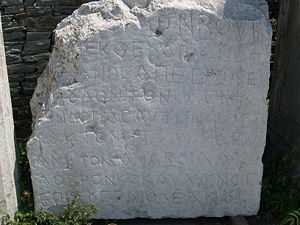Presian Inscription
The Presian Inscription or Philippi Inscription is a medieval Greek text inscribed upon a stone in Philippi during the reign of the Bulgarian ruler Presian I (r. 836–852).
Background history
In 837, soon after Presian's accession, the Slavs in the vicinity of Thessalonica rebelled against the Byzantine Empire. Emperor Theophilos sought Bulgarian support in putting down the rebellion, but simultaneously arranged for his fleet to sail through the Danube delta and undertake a clandestine evacuation of some of the Byzantine captives settled in trans-Danubian Bulgaria by the Bulgarian rulers Krum and Omurtag. In retaliation the kavhan Isbul campaigned along the Aegean coasts of Thrace and Macedonia and captured the city of Philippi, where he set up a surviving memorial inscription in a local church. Isbul's campaign may also have resulted in the establishment of Bulgarian suzerainty over the local Slavic tribe of the Smolyani.
Content
Original
| “ | Το]ν πολων Βου(λ)γα- ρον [ο] εκ θεου αρχον ο Π- |
” |
Translation
| “ | Of the many Bulgarians [the] by God lord Presian (Persianos) sent Isbul the kavkhan having given him military forces (fossata, "camps", metaphorically for "army") and the ichirgu-boil and the khan boil kolobron and the kavkhan against the Smolyani......If someone seeks the truth, God watches. And if one lies, God watches. The Bulgarians did many good things to the Christians and the Christians forgot, but God watches. | ” |
References
- Die protobulgarischen Inschriften By Veselin Beshevliev
- Southeastern Europe in the Middle Ages, 500-1250 By Florin Curta Page 166 ISBN 0-521-81539-8
- The early medieval Balkans By John Van Antwerp Fine Page 109 ISBN 0-472-08149-7

